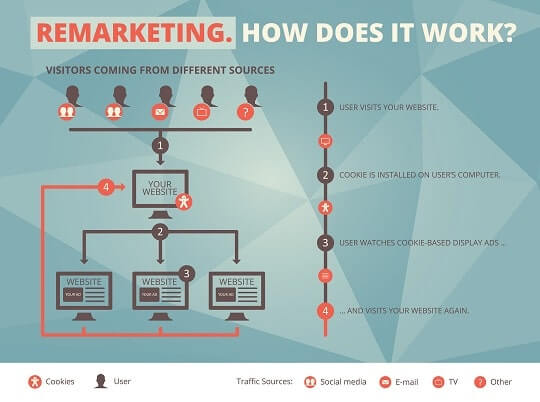Benefits of re-marketing audiences and conversion tracking
If you’re involved in any aspect of digital marketing, it is likely you have heard of both Conversion Tracking and Remarketing Audiences. But do you feel you have mastered these tools? Can you implement them effectively and do you have solid strategies in place to make the most of them? If not, I hope you’ll be inspired by this article!
Basic Definition and Introduction
First off, let’s start with some basic definitions. There are literally dozens of definitions out there, all of which overlap for about 97.5% (scientifically deducted number, of course). Here are the definitions in my own words:
Conversion tracking allows you to measure the efficiency of your marketing efforts. You can track everything from e-commerce transactions and revenue to newsletter sign-ups and chats. Ideally, a business will define 1 or 2 actions as conversions and every other measure action as a micro-conversion, meaning it’s not the end-goal but still important to measure.
A Remarketing Audience is a way of following people online that have previously visited your website or app. The most common ways of doing this are cookies and User IDs, but it’s also possible to upload lists with e-mail contacts or phone-numbers to some platforms.

Tag Management Systems
As your business grows in size, you’re probably starting to use more and more tools in your marketing mix or as part of your analysis efforts. Many of these tools come with their own pixels and tags that need to be installed on your site, often with different implementation rules, requirements and dynamic elements. As this requires a lot of development time, several companies have made attempts to simplify this process – which has resulted in something called Tag Management systems or Container Tags…
Container Tags consist of code that needs to be placed on every part of your website. They interlink with an online interface, which allows you to add code without actually updating the code on your site. Using firing rules, you have complete control over each tag in your container.
Not only do container tags make it much simpler to implement all the different tools necessary for a successful digital marketing strategy – they also extend the usefulness of tags by giving you a higher level of control! For example, you can easily set-up an AdWords remarketing tag that only fires if a user comes from Facebook, allowing you to create an ultra-segmented remarketing strategy.

In the past, I’ve worked both with the Google Tag Manager and with Opentag by Qubit. Both come with pre-configured libraries for a range of tools as well as the ability to use custom scripts. Both have advanced firing rules and triggers available and both can be used with dynamic elements. There are also other options out there such as DC Storm and Relay 24, but as I haven’t used them before I can’t make any recommendations, but it is important to look around to make sure it fits your requirements.
AdWords, Facebook and Google Analytics
Every platform has its own tags and with them, its own challenges and opportunities. The below is a non-exhaustive list of the most well-known platforms, their tags and some of the possibilities.
AdWords
AdWords comes with its standard conversion tag and remarketing pixel. Both can be customized to include information such as revenue and currency code.
The Conversion Tag needs to be placed on the success page of the action you want to record or, if you’re using a tag container solution, you need to set up custom firing rules that suit your purpose.
Then, there are two types of remarketing tags. One is the default tag that everyone has access to, which is easily implemented. All you need to do is copy-paste the code to your site and you’re good to go. The other is the dynamic remarketing tag. This tag changes depending on the type of business you are, to accommodate for the needs of specific businesses. Think along the lines of retail, hotels, flights etc. These tags come with dynamic elements which will allow you to show dynamically adjusted ads to users, depending on how they have interacted with your site.
At the moment, Facebook still has 2 tags – the Facebook pixel and a conversion pixel – but they are phasing out the old pixel so we’ll focus on the new one. The benefit of the new pixel is that it covers both the conversion tracking and the remarketing audiences. Simply create the pixel, install it on every page on your site and set up rules to define your audiences and conversions.
This pixel also allows dynamic remarketing, meaning you can pass custom information back to Facebook and then use that to serve dynamic ads to users based on their behaviour on your site, similar to AdWords dynamic remarketing.
Google Analytics
Similar to the new Facebook pixel, Google Analytics only comes with one tag that needs to be implemented on every part of your site. Once installed, you can create remarketing audiences that integrate with AdWords based on rules, but also define goals and transactions based on a number of rules.
Lastly, some Food for thought
I hope you found this article helpful and have come up with some ideas on how to use these tools for your own requirements! For some extra inspiration, have a look at this list of possible applications:
- Record Micro-Conversions to give your Ad Automation software more data to work with
- Create Remarketing audiences for Micro-Conversions so you can follow this high-intent audience and push them to make the sale
- Create Look-a-Like audiences based on audiences made up of Converters to take advantage of AdWords and Facebook knowledge about their users
- Use Google Analytics to create advanced Remarketing lists based on behaviour such as time on site and page depth
Do you have any questions about Conversion Pixels, Tag Management or Remarketing Strategies? Get in touch so we can have a conversation about how to support your company best!



